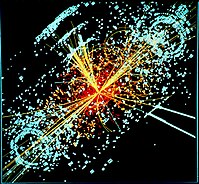
Photo from wikipedia
Ultradilute quantum droplets are intriguing new state of matter, in which the attractive mean-field force can be balanced by the repulsive force from quantum fluctuations to avoid collapse. Here, we… Click to show full abstract
Ultradilute quantum droplets are intriguing new state of matter, in which the attractive mean-field force can be balanced by the repulsive force from quantum fluctuations to avoid collapse. Here, we present a microscopic theory of ultradilute quantum droplets in three-, one- and two-dimensional two-component Bose-Bose mixtures, by generalizing the conventional Bogoliubov theory to include the bosonic pairing arising from the interspecies attraction. Our pairing theory is fully equivalent to a variational approach and hence gives an upper bound for the energy of quantum droplets. In three dimensions, we predict the existence of a strongly interacting Bose droplet at the crossover from Bose-Einstein condensates (BEC) to Bardeen--Cooper--Schrieffer (BCS) superfluids and map out the bosonic BEC-BCS crossover phase diagram. In one dimension, we find that the energy of the one-dimensional Bose droplet calculated by the pairing theory is in an excellent agreement with the latest diffusion Monte Carlo simulation {[}Phys. Rev. Lett. \textbf{122}, 105302 (2019){]}, for nearly all the interaction strengths at which quantum droplets exist. In two dimensions, we show that Bose droplets disappear and may turn into a soliton-like many-body bound state, when the interspecies attraction exceeds a critical value. Below the threshold, the pairing theory predicts more or less the same results as the Bogoliubov theory derived by Petrov and Astrakharchik {[}Phys. Rev. Lett. \textbf{117}, 100401 (2016){]}. The predicted energies from both theories are higher than the diffusion Monte Carlo results, due to the weak interspecies attraction and the increasingly important role played by the beyond-Bogoliubov-approximation effect in two dimensions.
Journal Title: Physical Review A
Year Published: 2020
Link to full text (if available)
Share on Social Media: Sign Up to like & get
recommendations!